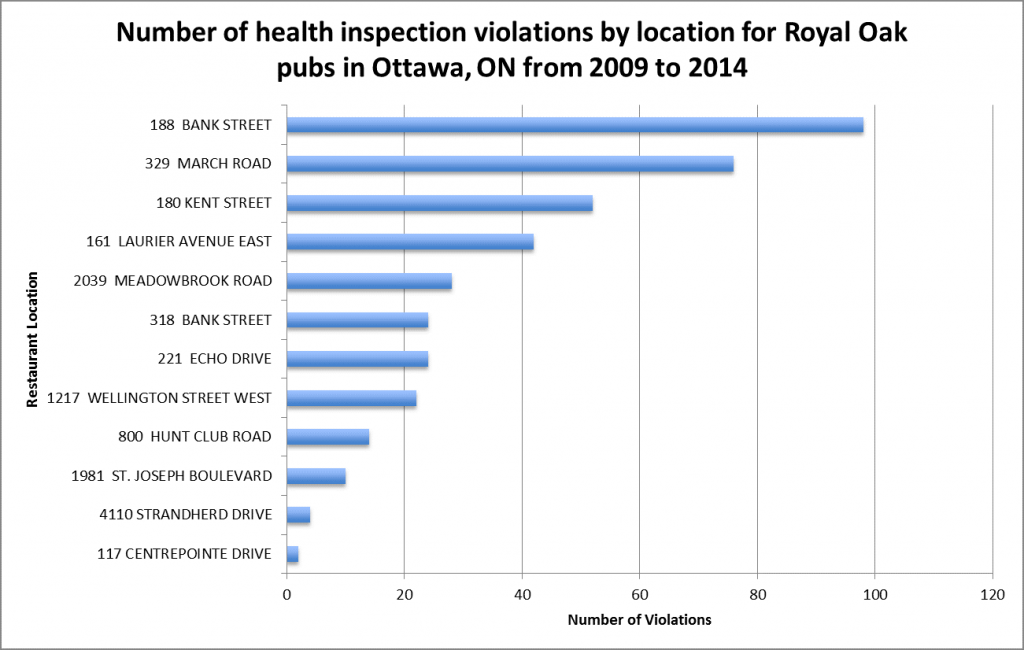By Craig Lord
As baby boomers begin to approach old age en masse, retirement residences in Ottawa are increasingly becoming the target of food inspectors.
Looking at the City of Ottawa’s restaurant inspections data from 2009 to 2014, which includes retirement residences and any such food premises, the number of inspections of retirement homes increased by 387.5 per cent over those years. Compare that to the total number of food inspections in the city, which rose by just 59.9 per cent over the same period.
Recently, too, the majority of infractions are coming from just four residences. The Promenade, Palisades, Redwoods, and Chartwell Heritage Retirement Residences account for more than half of violations from all residences from 2014 to May of 2015.
Peter Kocoris, general manager of the Promenade Retirement Residence, says that the violations aren’t always indicators of a poor kitchen condition. Most infractions are minor, like an unfilled soap dispenser, and do not pose immediate risk or cause for closure.
“If they have a finding, you could correct it right on the spot,” he says. “For the most part, it’s something that can be fixed.”
Kocoris, a former chef by trade, feels the Promenade is a well-maintained operation. He says there is continuous quality improvement internally, and that the occasional violation shouldn’t affect the confidence of patrons.
“Put it this way: I eat here too.”
The risk for seniors is higher with regards to food sanitation. Brenda Watson, executive director of the Canadian Partnership for Consumer Food Safety Education, says that the aging population is as vulnerable as children and pregnant women.
“Seniors are at greater risk. They just have to be extra diligent in practicing in safe-food handling,” she says.
Despite this, the standards for retirement residence inspections are the same for most other food premises. Ottawa Public Health says that retirement residences are inspected a minimum of three times per year, with regular offenders receiving additional inspections. The only difference in standards between a retirement home and a typical restaurant is that retirement homes require one member of the food preparation staff to be certified by Ottawa Public Health.
Kocoris says that the risks associated with serving seniors are well documented, and acknowledges the additional responsibility.
“I think the standards are higher.”
Kocoris recalls the 2008 Maple Leaf Foods listeriosis outbreak. Toronto Public Health ramped up its investigations into a possible outbreak when a case of listeriosis was documented at a nursing home.
“People are more food-savvy now,” he says.
Since food inspections became a matter of public record in Ottawa, the ease of comparing residences for sanitation infractions has meant a tighter leash for any food establishment. Instead of feeling pressured by this reality, Kocoris says he and other residence managers should welcome the scrutiny.
“People should do their homework. … Nobody wants to put their parent in harm’s way. Honestly, most retirement homes should have an open-door policy. Show off the kitchens; show off how clean they are. People ask those types of questions now.”
Were his residence to ever face closure over a major infraction, Kocoris realizes there’s no coming back.
“It’s a public relations nightmare for not only retirement homes, but for any restaurant, to have a food poisoning issue. That’s your bread and butter. That’s your business. The last thing you want is to be in non-compliance.”























 According to Kathryn Downey, Supervisor of Health Inspection at Ottawa Public Health,
According to Kathryn Downey, Supervisor of Health Inspection at Ottawa Public Health, 